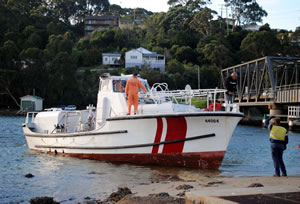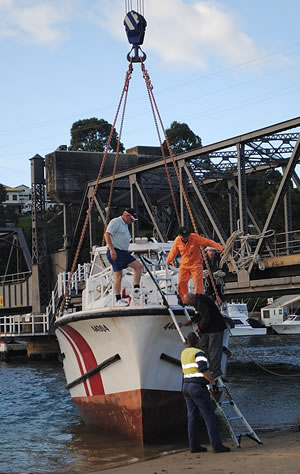





 After serving the port of Narooma for more than 10 years, the lifeboat Strathmore was lifted into a flatbed truck to start a third life.
After serving the port of Narooma for more than 10 years, the lifeboat Strathmore was lifted into a flatbed truck to start a third life. So, at 2030, Coxswain Cannon steered close to the south of the trawler and then, turning to starboard, brought the lifeboat up to her port quarter. The trawler was lying head west and pounding forward, the stern appearing to be fast aground. As the two vessels closed Crew Member Michael Petts leapt from the lifeboat and, with the help of the trawler's crew, was pulled aboard.
So, at 2030, Coxswain Cannon steered close to the south of the trawler and then, turning to starboard, brought the lifeboat up to her port quarter. The trawler was lying head west and pounding forward, the stern appearing to be fast aground. As the two vessels closed Crew Member Michael Petts leapt from the lifeboat and, with the help of the trawler's crew, was pulled aboard. Marine Rescue Narooma division commander Graham Brown in June last year was attempting to dock the 44-year-old Strathmore at the Narooma wharf when his starboard engine failed and word came up from the engine room that its gearbox had blown a seal and had drained dry.
Marine Rescue Narooma division commander Graham Brown in June last year was attempting to dock the 44-year-old Strathmore at the Narooma wharf when his starboard engine failed and word came up from the engine room that its gearbox had blown a seal and had drained dry.